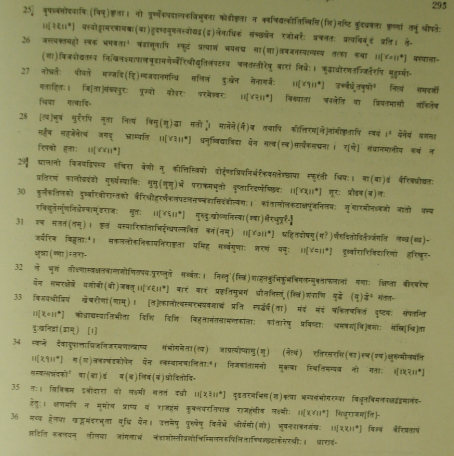| |
North
Indian Inscriptions |
| |
|
|
|
INSCRIPTIONS OF THE PARAMARAS OF VAGADA
ARTHŪNA STONE INSCRIPTION OF CHĀMUNḌARĀJA

_____________________________________________________
[1] Engraved तां. with the sign of anusvāra erased later on.
[2] Here is a pun on vṛisha and the other words suggesting the king to be identical with Śiva who is also
known as Tripurāti who destroyed three cities, whereas this king conquered many. Vṛisha means (1) dhar-
ma, and (2) bull
[3] The punctuation mark is redundant. The restoration mānēn=ē(ai)va in the beginning of this foot is as
suggested by Barnett, but I agree with the editor in retaining the original. The akshara ṇē in the same line
is lost and has been restored from Barnett’s reading.
[4] Metrically the first akshara of this word is required to be guru. Its consonant is rather indistinct and
the second akshara seems to have had a subscript, which too is equally indistinct. From traces on the
original I take word as विह्नुता: or विहुंता:. From his indifferent rubbing Barnett also read vēdārinā
that follows in the same line, but the curve of the mātrā of the first of these letters is clear in my impression as well as in the original.
[5] This akshara with a part of the preceding one is lost and has been restored from Barnett’s reading. As
also noted by him, this verse imitates the style of the Mēghadūta.
[6] This sign of visarga is put here after the daṇḍa and नेरथं and का in this line are lost; they have been restored.
from Barnett’s reading.
[7] Read शश्वत्. The aksharas are exactly as transcribed here. They were read by Barnett as Sasvatannadakō
and correcting them to sa-Śatānaṁdakō, whereas the editor suggesting, with a query-mark, śaśvat-unnati
gō, which is all due to the indifferent impressing. as already stated. This verse has an allusion to the
Vāmana avatāra of Vishṇu.
|
\D7
![]()
|








